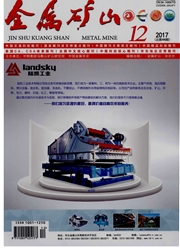

 中文摘要:
中文摘要:
为探究无底柱分段崩落法回采挂帮矿的可行性,以四川某铜矿东露天1#挂帮矿开采为工程背景,建立了拉张破坏有限元模型,分析了挂帮矿在各分段回采过程中上部坡体内第一主应力演变过程和裂纹扩展过程。结果表明:各分段回采时,初始拉应力在坡面集中,裂纹在坡面产生后随主应力释放—转移—集中的过程不断向深部扩展,直至贯通采场;各分段矿石回采结束后形成的采空区能容纳塌落的松散岩体,无底柱分段崩落法开采挂帮矿诱发的边坡岩移可以得到有效控制,能满足露天坑底的安全生产条件。
 英文摘要:
英文摘要:
In order to discuss the feasibility of mining hanging wall ore with non-pillar sublevel caving method,taking 1#hanging wall ore mining of the east open-pit of a copper mine in Sichuan Province as the engineering background,the crackgrowth process and evolution process of the first principal stress of the upper slope during the stoping process of each sections of hanging wall ore are analyzed in detail. The study results show that the during the stoping process of each sections,initial tensile stress is concentrated on the surface of slope,after the crack is generated firstly on the slope surface,then is extended continuously into the deep of slope with the changing process of release-transfer-concentration of the principal stress,eventually penetrating the slope; the loose collapsing-rock can be processed effectively by the goaf caused by stoping process of each sections. The above analysis results further show that the slope displacement induced by the hanging wall ore mining by non-pillar sublevel caving method can be controlled effectively and the safety production conditions of open-pit bottom can also be guaranteed.
 同期刊论文项目
同期刊论文项目
 同项目期刊论文
同项目期刊论文
 期刊信息
期刊信息
